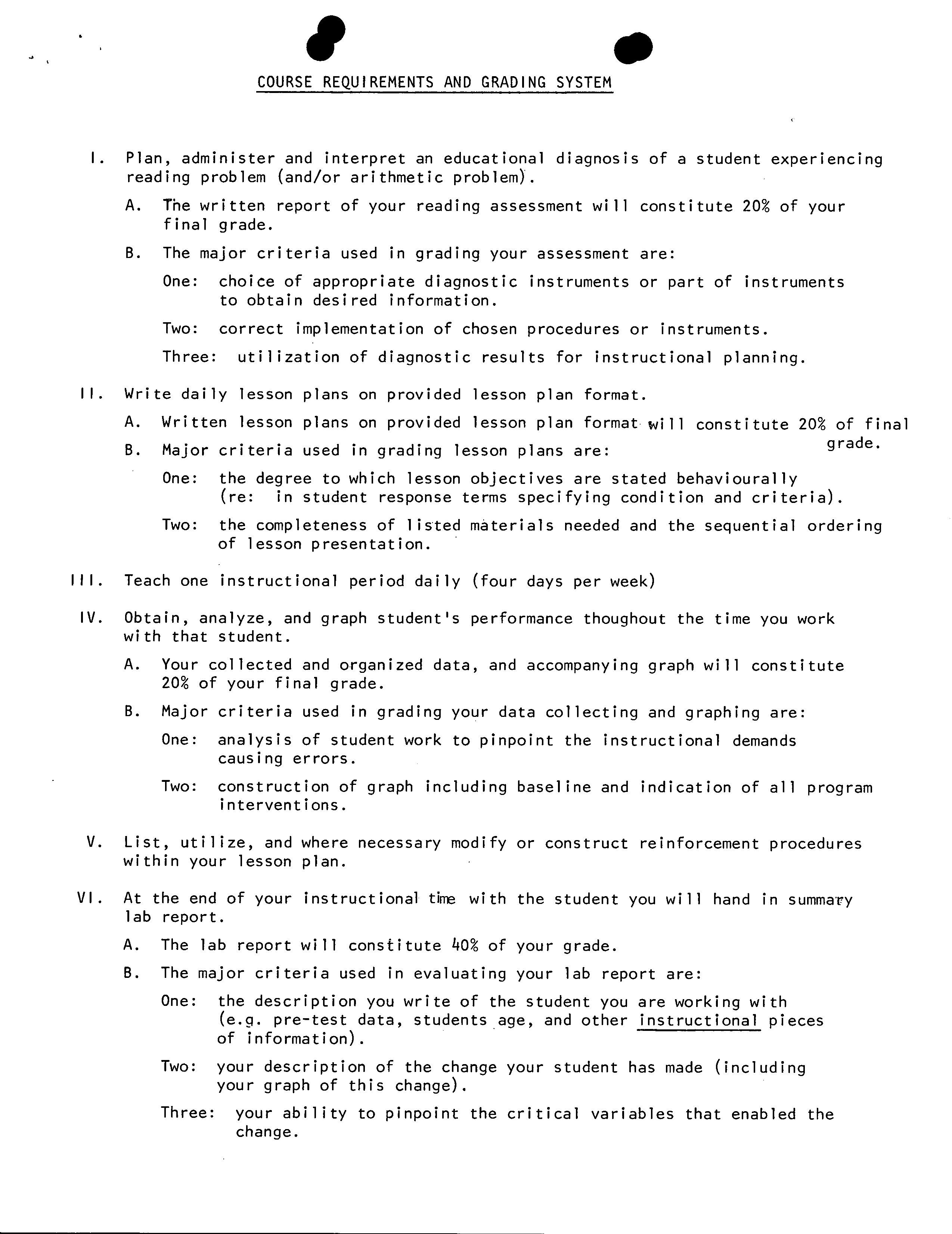r
_^,
?
.
EDUCATION 424-4
LEARNING DISABILITIES LABORATORY
SUMMER SESSION (July 7th - August 15th)1j'
Monday - 8:30 - 12 noon
Tuesday, Wednesday, Thursday -
11:00 - 12 noon
INSTRUCTOR: Stanley Auerbach
Work number: 946-7601
Home ?
11:
?
531-8551
LOCATION: Lord Baden-Powell Elementary School
450 Joyce
Coquitlam
Phone: 936-1436
***NOTE: 1st Meeting will be on campus
on Monday, July 7th from 12:30 - 4:30
in MPX 8642
COURSE DESCRIPTION
Development and evaluation of precise teaching skills for the treatment of children with
Learning Disabilities. This is a laboratory course.
?
In order for both you and your pupil
to receive full benefit from this course you must work together four days per week.
COURSE OUTLINE: Grading
1.
Plan,
experiencing
administer
reading
and interpret
problems (and/or
an educational
arithmetic
diagnosis
problems)
of a pupil
?
20
2.
Plan a daily lesson plan on lesson plan format sheet
?
20?
3.
Teach one instruction period per day - your pupil expects you
4.
Graph students performance ?
20%
5.
Analyse and/or construct reinforcement contingencies
6.
Write a lab report to summarize your instruction with your pupil
?
40
REQUIRED READING
/
1. Syllabus of readings and testing materials will be purchased from the instructor.
2. HARING, LOVITT, EATON, HANSEN; THE FOURTH R RESEARCH IN THE CLASSROOM; Charles E.
Merrill Pub., 1978
7
RECOMMENDED READING
O
1. ALLEY, G. DESHLER, D.; LEARNING THE DISABLED ADOLESCENT: Strategies and Methods;
Love Pub., Denver, 1979
2. AXELROD, Saul; BEHAVIOUR MODIFICATION FOR THE CLASSROOM TEACHER; New Yo
.
rki McGraw—Hill,
1977
- 3.. ENGLEMANN; PREVENTINGFAILURE IN PRIMARY GRADES; S.R,A,
S
?
.
COURSE REQUIREMENTS AND GRADING SYSTEM
I. Plan, administer and interpret an educational diagnosis of a student experiencing
reading problem (and/or arithmetic problem).
A.
The written report of your reading assessment will constitute 20? of your
final grade.
B.
The major criteria used in grading your assessment are:
One: choice of appropriate diagnostic instruments or part of instruments
to obtain desired information.
Two: correct implementation of chosen procedures or instruments.
Three: utilization of diagnostic results for instructional planning.
II. Write daily lesson plans on provided lesson plan format.
A.
Written lesson plans on provided lesson plan format will constitute 20 of final
B.
Major criteria used in grading lesson plans are: ?
grade.
One: the degree to which lesson objectives are stated behaviourally
(re: ?
in student response terms specifying condition and criteria).
Two: the completeness of listed materials needed and the sequential ordering
of lesson presentation.
III. Teach one instructional period daily (four days per week)
IV. Obtain, analyze, and graph student's performance thoughout the time you work
with that student.
A.
Your collected and organized data, and accompanying graph will constitute
20 of your final grade.
B.
Major criteria used in grading your data collecting and graphing are:
One: analysis of student work to pinpoint the instructional demands
causing errors.
Two: construction of graph including baseline and indication of all program
interventions.
V. List, utilize, and where necessary modify or construct reinforcement procedures
within your lesson plan.
VI. At the end of your instructional time with the student you will hand in summary
lab report.
A.
The lab report will constitute
?
of your grade.
B.
The major criteria used in evaluating your lab report are:
One: the description you write of the student you are working with
(e.
g
. pre-test data, students age, and other instructional pieces
of information).
Two: your description of the change your student has made (including
your graph of this change).
Three: your ability to pinpoint the critical variables that enabled the
change.


